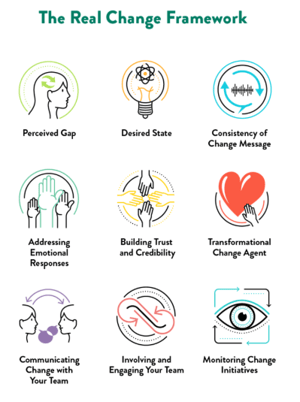Making Organisational Changes Last
It’s no secret that organisations all around the world are in need of change. Not one day passes without having at least one news item that covers the topic of companies adopting Industry 4.0, or exploring ways in which Artificial Intelligence can serve in taking businesses to greater heights.
As you know, most companies aren’t able to change overnight. Implementing change is a journey that needs managing. As part of our series on change management, we have covered the topics of how to get buy-in for change initiatives and dealing with resistance to change in previous articles. Now we are going to look at how you can make your changes last.
The Real Change Framework

The 9 enablers of the Real Change Framework authored by Dr. Lily Cheng, work together to increase the level of commitment to change amongst the recipients, resulting in greater success and effectiveness of organisation-wide changes.
In this article you will learn about how to sustain your change efforts, by identifying opportunities for positive change focusing on the process enablers “Communicating Change With Your Team”, “Involving and Engaging Your Team” and “Monitoring Change Initiatives”.
Communicating Change With Your Team
Everyone who is affected by the change needs to be aware of
- why things are changing
- what exactly is changing
- when changes are going to happen
- how the changes affect the individual and how he/she is going to be involved
- what behavioural changes are expected
It is not going to have the desired effect if you merely send out an email to everyone, informing them about these things. You need to be creating an open channel of communication where a dialogue can occur between your change agents and their team.
Effective communication is crucial to the success of any organisational change effort. Recipients of change can easily get confused and frustrated with the process - to avoid this, you need to have clear and honest conversations about the expected changes and how people are involved.
When communicating change with your team, your conversations must be real. This means you need to be confident to confront your employees with “real issues” that the changes may entail, with the intention of interacting and achieving a shared understanding.
Involving and Engaging Your Team
The successful implementation of your change initiatives is highly dependent on the change recipients’ commitment to the process. Empowerment and commitment can be achieved by making sure to engage and involve everyone of your team members.
As a leader, you need to create an inclusive change environment in which everyone feels belonged, by promoting a collaborative and respectful environment in which relationship are based on open communication.
For your people to embrace change, they need to be part of it. Nobody feels inspired to change their behaviour when expectations are just being ‘dumped’ upon them. Find ways of engaging your team members by getting them to fully understand how their role contributes to the big picture.
Monitoring Change Initiatives
The last thing you want is to put a great deal of effort into implementing change just to find that the changes don’t stick, because people are going back to doing things the old way.
To ensure stabilisation of the new norms, you need to be monitoring your change initiatives closely, by creating feedback systems that provide you with continuous reports. Having a clear change road map that includes the performance expectations of respective functional teams for the feedback system to be based on is essential.
What to expect from the Real Change Framework
The Real Change Framework with its 9 enablers goes beyond helping organisations reach a desired state of change by enabling them to be change-agile. It empowers organisations to identify opportunities for positive change and to proactively make transitions through change.
Apart from that, the Real Change Framework can also be used as a diagnostic tool to identify which enablers of change need attention, due to weakness in the organisation. Focusing your efforts on these will ensure a targeted approach to achieving your organisational objectives.
To find out more about how Real Change can serve you in equipping and aligning your people to face the challenges of change, download our brochure here!


